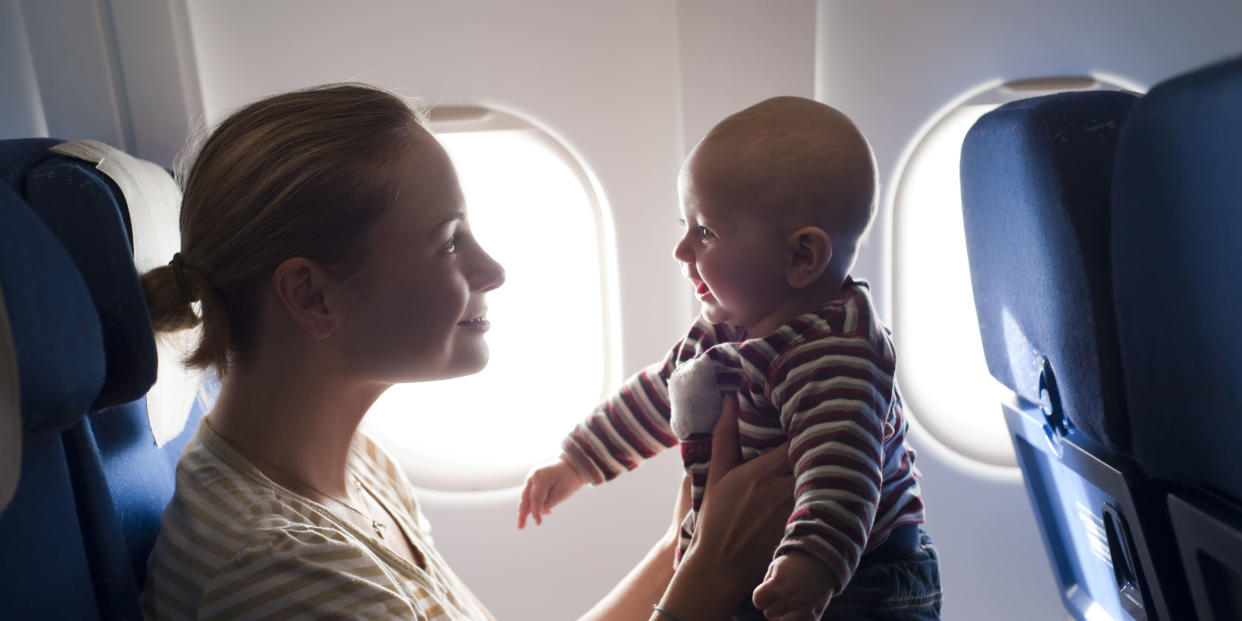The Scary Way You're Probably Putting Your Baby at Risk When Flying

It started as a peaceful flight. About 40 minutes before landing, some of the 318 passengers on the May 1st Aeroflot flight from Moscow to Bangkok, Thailand, were taking the opportunity to use the restroom before the seat belt light flicked back on. That's when it happened: Severe turbulence threw people around, knocking some down into the aisles. The airplane had encountered an "air hole", and while it only lasted 10 seconds, the damage was evident: broken bones, bruised faces, blood on the cabin ceiling, and babies with head injuries. Though thankfully no one died, 27 people were hospitalized-including a one-year-old.
This scary news story had us wondering: What more can we do to keep our kids safe on airplanes? The same thing you'd do during a drive, says Allana Pinkerton, Certified Child Passenger Safety Technician and Global Safety Advocate at diono: Put them in a car seat.
Baby on Board
"Overall, when we think of car seat use, whether on an airplane or in a car, it's a lot like insurance. You pay for it up front, but do not need it until there is an incident to use it," Pinkerton tells WomansDay.com. "In this case, an airplane crash is highly unlikely [about one in 5.4 million, according to the Economist]. However, rough takeoffs, landings, and turbulence are quite common. During these scenarios, it is safer for a child to be in their five point harness to adequately protect them."
Currently, most airlines do not require car seats (or even seats) for children under the age of two. Why? "I'm afraid it all comes down to dollars and some complications," Pinkerton says. "Airlines are fearful customers would drive rather than fly if they have to purchase a seat for their child, and not all car seats fit on every airplane."
Still, most airline websites contain information about using car seats on planes. And the Federal Aviation Administration (FAA) strongly advises that the safest option is a government-approved child safety restraint system (CRS) or device, also known as a car seat. For older kids, there's also the CARES Child Safety Device, a harness that slips over the seat and straps around your child with the help of the seat belt. In general, the same car seat requirements for age, height, and weight apply to planes as well.
"Your arms aren't capable of holding your child securely, especially during unexpected turbulence," the FAA website explains.
And the alternative, strapping baby inside your own seat belt, could cause you to crush him or her with the weight of your body.
"The laws of physics do not change just because you're on an airplane. In fact, they increase exponentially with a plane taking off and landing at roughly 250 mph."
A Risky Decision
If it's the safest way to fly, why don't you see more car seats on airplanes? (FYI, there are only two photos of car seats on airplanes on Getty Images.) The first reason seems to be that flying with infants on your lap is legal, not to mention an obvious money-saver. If cost is an issue, it's important to note that some airlines, like Southwest, do offer "affordable infant fares" for kids under two-and for those that don't, you can always call and try to negotiate over the phone (play the safety card!). If you find yourself on an undersold plane, you can also ask if the airline will give your child one of the empty seats, says FAA.
Other than price, Pinkerton also says parents simply aren't aware of the risk. "There is no way to predict when these incidents will occur, just like we cannot predict a car crash," she says. "I always say 'Err on the side of caution.' If your child is not properly secured, they risk being injured or killed."
A third reason could be convenience-parents might not want to add one more large item to the list of things they have to lug around. While that's perfectly understandable, today's models (like convertibles you can wear as backpacks) are much more travel-friendly.
How to Choose an FAA-Certified Car Seat
Don't go out and buy a new car seat just yet: There's a good chance the one you already have in your vehicle is FAA-approved-check the manual or look for the airplane illustration on the label, and make sure it measures at or under 16 inches wide. Installing is easy: Just follow the instructions in the manual. "In general, place the lap belt through the correct belt path," Pinkerton says. "Buckle the seat belt and pull it tight so there is less than one inch of movement in either direction. Depending on your car seat, you may need to get a seat belt extender from the airline."
Keep in mind that flight attendants will probably instruct you to put the car seat in the seat by the window so it's not in the exit path of other passengers.
Another bonus? "You and your child will be more comfortable, and they will be in a familiar area-their car seat," Pinkerton adds. "It just might make your trip more pleasant for all of you."
You Might Also Like
